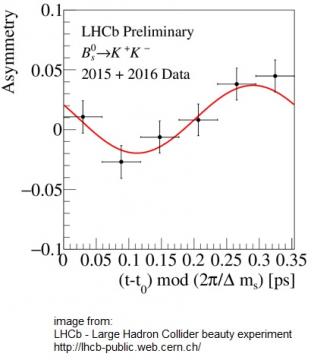
The Big Bang should have created equal amounts of matter and antimatter in the early universe, starting from a state of pure energy.
But in the world we live in today, and in the one accessible to our telescopes, there is not much antimatter.
One of the greatest challenges in Physics is to figure out what happened.
The symmetry between matter and antimatter (called CP symmetry) is studied in detail by the LHCb experiment with analysis of the particles produced in proton-proton collisions in the LHC accelerator at CERN, in particular the "beauty" mesons (B). In a fascinating world of quantum mechanics the B0 and Bs0 mesons turn into their antiparticles and back.
The oscillation frequency of the B0 mesons is about 8*1010 times per second, while the frequency of Bs0 is much larger, about 3*1010 times per second. During oscillations an asymmetry is observed, called the time-dependent CP violation, which has been first measured in 2001 for B0 mesons.
On October 6th, the LHCb collaboration announced the first observation of time-dependent CP violation in Bs0 decays, studying the decays of Bs0 into two charged kaons, Bs0->K+K-. The asymmetry is visible in the image which illustrates the difference between the number of decays of anti-Bs0 and Bs0, compared with their sum, as a function of the decay time of the mesons.
This study involved the Department of Physics and in particular was the subject of DavideFazzini’s Ph.D. thesis (cycle XXXII of the Ph.D. in Physics and Astronomy).